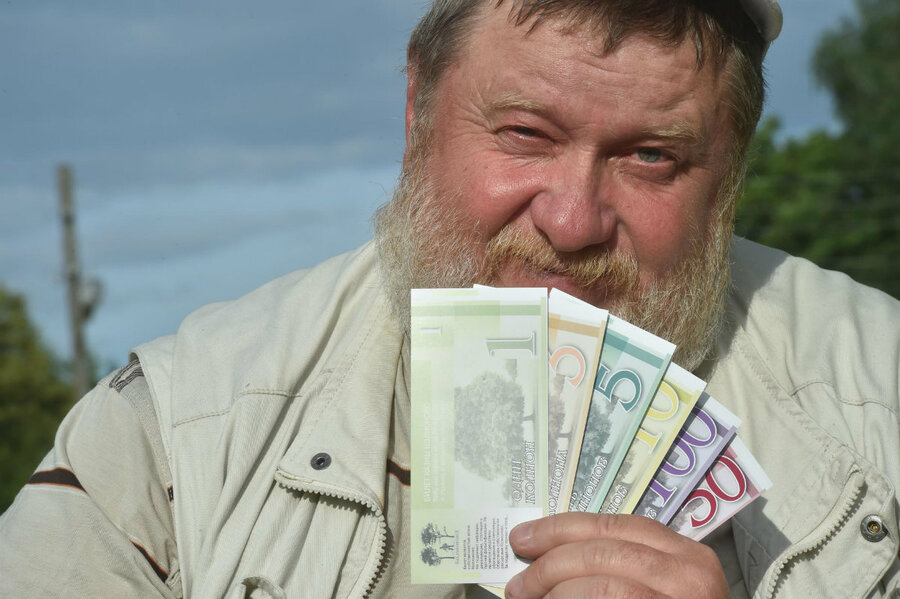He calls it a 'hustle,' but this Russian’s cryptocurrency empowers a village
| Russia
A family farm in Kolionovo, a rural village on the outskirts of Moscow, has become a role model of circular economy, thanks to the launch of the first agricultural Initial Coin Offering – a fundraising system similar to public offerings but based on cryptocurrencies (ICO) – on the Russian market. Behind the project is farmer Mikhail Shlyapnikov, who identifies himself as “an old anarchist” and has given up relying on state support to make a living.
The Russian government plans to allocate 5.2 billion rubles ($84 million) in soft loans to agro-industrial projects this year. In 2017, farmers received 6.5 billion rubles through 8,000 soft loans. However, 80 percent of these loans go to big farms and holding groups, which constitute only two percent of all agro producers, leaving most rural villagers with no other choice but to provide for themselves. “You either wait for favors from the state or create good life conditions by yourself,” says Mr. Shlyapnikov.
The farmer, who was a businessman and a banker in the 1990s, moved to the village in 2007 after being diagnosed with an inoperable cancer. He now owns 25 hectares of land where he grows seeds and rents about 75 hectares more to grow crops and potatoes. But his peaceful retirement plans turned into the creation of a successful agricultural project instead: to cope with the economic crisis, he decided to create a new local currency, the kolion.
Kolions were guaranteed by the farm’s assets – a bag of potatoes or a goose – and allowed the farmer to sell his crops for half their price inside Kolionovo, trade with suppliers, and pay his workers. He was even able to transform an old village hospital into a greenhouse.
But a year later a criminal case was built against him for issuing his own paper currency. The court concluded that his actions undermined the government’s financial system, and the kolions were banned.
The clash with the state did little to stop Shlyapnikov, who then turned to the blockchain market to find investors for his farm. In 2016, he launched the first ICO fundraiser on blockchain, collecting the equivalent of about 800,000 rubles on Emercoin. Investors received a delivery of the farm’s products, while the profits went into developing the farm. In April 2017, the farmer released the kolion token [KLN] on the Waves platform. In one month he collected 401 bitcoins – 31.6 million rubles – from 103 investors. By February 2018 the sum exceeded 300 million rubles.
“It’s not so bad for one farm in a village with a population of four,” Shlyapnikov muses. But like with any other cryptocurrency, the KLN exchange rate is highly volatile – its value multiplied by nine in six months, then rolled back.
The ICO’s purpose was not just survival, but to create an alternative way to develop and to deal with seasonal cash scarcity, independent of state support and bank loans. “Farmers generally need money in spring, but the profits don’t come before autumn,” explains Shlyapnikov. Today, he considers this model viable. “Everything goes according to plans, the farm keeps on developing.”
He refers to his system based on pre-paid orders as “any farmer’s dream” – some of the products are paid for years in advance. Shlyapnikov also uses the crypto tokens while dealing with suppliers and consumers, thus involving neighboring farms in his local economy. In addition to regular dividends, kolion holders receive a discount for paying with the cryptocurrency. In December 2017, most of the farm’s Christmas trees were purchased with it.
Kolions are traded on the stock exchange but they can’t be “mined” like bitcoins. Instead, the farmer invites those willing to earn some kolions to the farm, telling them to “get a shovel and clean up after the pigs.”
While calling himself an anarchist, the cryptofarmer is not ready for direct confrontation with the state. “Obviously, we have all the necessary licenses and stamps, bank accounts and bookkeeping reports. We pay taxes and all kinds of fees. The kolion model is a superstructure above the existing system,” says Shlyapnikov, noting that Russia might shut down his “hustle” at any moment, but that he is ready to enter the legal space if the legislation on cryptocurrencies turns out to be liberal enough.
Shlyapnikov plans on strengthening the kolion ecosystem by creating insurance and hedging mechanisms to protect it from volatility, and also forming his own banking system to simplify investors’ and customers’ dealings with the currency. His aim is to create an independent economic model in agriculture, built on freedom, independence, and self-sufficiency.
At the same time, the farmer is transferring his model to Belarus, where the ICO procedure was legalized last December. He plans on growing potatoes there.
This story was reported by Kommersant, a news outlet in Russia. The Monitor is publishing it as part of an international effort by more than 50 news organizations worldwide to promote solutions journalism. To read other stories in this joint project, please click here.






